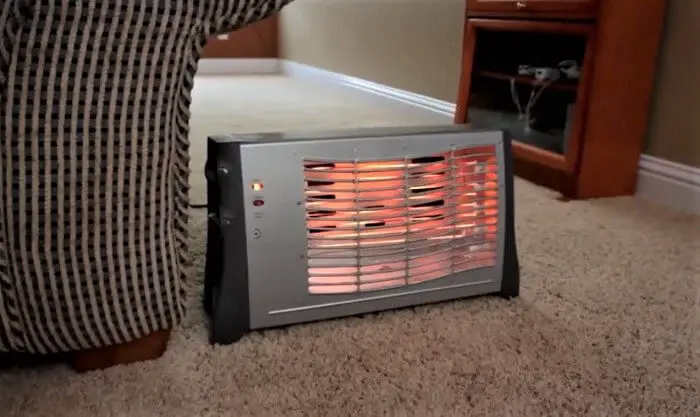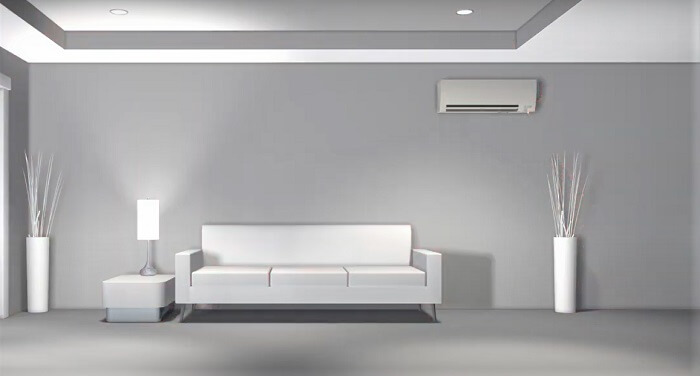| Note: This article may contain affiliate links, which means if you make a purchase following our links won’t cost you extra, but we may earn a commission. Learn more |
As the colder months approach, many people find themselves reaching for a space heater to keep warm. But have you ever wondered why space heaters are usually placed near the floor? There are a few reasons for this.
For one, cold air is heavier than warm air and sinks to the lowest point in a room. By placing a space heater near the floor, you can take advantage of this natural phenomenon and direct warmth where it’s needed most. Additionally, floors are typically less insulated than walls, so heat loss is minimized when a space heater is used in this way.
Keeping a space heater close to the ground helps prevent accidental fires. Space heaters can get very hot, and if they’re placed too high up, they may come into contact with combustible materials like curtains or bedding. By keeping them close to the floor, you can reduce the risk of fire hazards.
Most people don’t think about why a room heater is placed near the floor, they just know that’s where it goes. But there’s actually a very good reason for this – heat rises. So by placing the room heater near the floor, you’re ensuring that the heated air will rise and circulate around the room, rather than just sitting near the ceiling.
This is much more efficient and will help to heat up the room more quickly. So next time you go to switch on your room heater, remember that there’s a method to the madness!

Why Are Heaters Fitted near the Floor And Air Conditioners near the Ceiling in a Room?
There are a few reasons for this common HVAC placement. The first has to do with heat rising. Hot air rises, so it makes sense to place the heater near the floor where it can more easily circulate throughout the room.
Additionally, having the heater close to the floor means that any cold drafts from windows or doors will be less likely to reach you since they have farther to travel.As for air conditioners, there are a few reasons for their high placement as well. Again, hot air rises, so it needs to be cooled at the top of the room where it is concentrated.
Additionally, putting the AC unit up high means that cool air will sink down and fill the lower levels of the room first before rising back up again. This can help create a more even temperature throughout the space.
Would It Be Best to Place a Heater on the Floor Or Ceiling?
This is a basic law of physics that states that hot air will always rise towards the ceiling. This is why you often see heaters placed on the floor in rooms with high ceilings – the heat will eventually reach the upper levels of the room.
However, placing a heater on the floor also has a number of other benefits. For one, it helps to evenly distribute the heat throughout the room. If the heater is placed on a raised surface, the heat will be concentrated in one area and can often make the room feel uncomfortably warm.
Another reason why heaters should be placed on the floor is for safety reasons. If a heater is placed on a raised surface, there is a greater risk of it tipping over and causing serious injuries. However, if the heater is placed on the floor, it is much less likely to tip over.
Finally, placing a heater on the floor can actually save you money. Heaters that are placed on the floor are often less expensive to operate than those that are placed on a raised surface. This is because the floor is a better conductor of heat, which means that the heater will not have to work as hard to heat the room.
Overall, there are a number of scientific reasons why heaters should be placed on the floor. Not only does this help to evenly distribute the heat, but it also helps to keep the room safer and can even save you money.

Why is a room heater placed near the floor and an air conditioner near the ceiling? | Toppr
Where to Place Room Heater?
Room heaters are a great way to keep your home warm and comfortable during the colder months. But where should you place your room heater? Here are a few tips to help you choose the best location for your room heater:
1. Place your room heater in a central location and near at floor. This will help evenly distribute the heat throughout the room.
2. Avoid placing your room heater near any flammable materials, such as curtains or furniture.
3. Make sure there is plenty of clearance around your room heater so that it doesn’t overheat or become a fire hazard.
4. If possible, position your room heater near an outlet so you can easily plug it in and turn it on when needed.
5. Lastly, consider using a timer for your room heater so that it automatically turns off after a set amount of time, preventing any accidents or fires from happening overnight while you’re asleep.
Room Heater
Most people think of a room heater as a simple appliance. But there is more to consider when you are buying one than just the size and shape. Room heaters come in many different types and each has its own set of features.
Here is a rundown of the most popular types of room heaters so that you can make an informed decision when shopping for one. The first type of room heater is the convection heater. These work by circulating hot air around the room using fans.
They are usually very quiet and have adjustable thermostats so that you can control the temperature easily. Some models also come with timers so that you can set them to turn off after a certain period of time. The second type of room heater is the radiant heater.
These work by emitting infrared radiation, which heats up objects in the room rather than the air itself. Radiant heaters are often used in combination with other heating methods, such as convection because they provide a more even distribution of heat throughout the space. They can be less energy-efficient than other types of heaters, however, so it is important to compare models before making your purchase.
The third type of room heater is the oil-filled radiator. These work by heating oil inside metal coils and then circulating it around the room using fans or natural convection currents. Oil-filled radiators are very efficient at heating large spaces and they tend to retain heat longer than other types of heaters, making them ideal for use in rooms where people will be sitting or lying down for long periods of time (such as living rooms or bedrooms).
However, they can be quite expensive to purchase and operate, so you’ll need to weigh your options carefully before deciding if this type of heater is right for you.
Small Space Heater
Small space heaters are an easy way to add extra warmth to your home without having to crank up the thermostat. They come in a variety of sizes and styles, so you can find one that fits your needs. Here are a few things to keep in mind when shopping for a small space heater:
-Heating capacity: Small space heaters typically have a heating capacity of around 1000-1500 watts. This is enough to heat a small room or office space.-Safety features: Look for a small space heater with safety features like tip-over protection and automatic shut-off.
These will help prevent accidents and fires.-Ease of use: Choose a small space heater that is easy to use, with clear controls and an indicator light. Some models even come with remote controls!
Small Heater Fan
If you’re looking for a small, compact heater fan to take with you on the go or to use in a small space, then you’ll want to check out the small heater fan. This handy little device is perfect for taking the chill out of the air, and can even be used to dry wet clothes or towels. The small heater fan comes in a variety of sizes and styles, so you’re sure to find one that’s just right for your needs.
And because it’s so compact and easy to carry, you can take it anywhere you go. So whether you’re headed off to the office or heading out for a weekend camping trip, be sure to bring along your small heater fan!
Learn More: 9 Common Oil Heater Problems And Their Solutions
The Bottom Line
A room heater is placed near the floor for several reasons. One reason is that heat rises, so placing the heater near the floor allows the heat to rise and circulate throughout the room. Another reason is that it is more energy efficient to place the heater near the floor because it takes less energy to heat up a smaller space.
Additionally, placing the heater near the floor helps to prevent accidental fires because it is out of reach of children and pets.